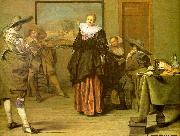
|
Pietro Longhi
|
|||
|
|
|||
| 1702-1785 Italian Pietro Longhi Galleries Pietro Longhi was born in Venice in the parish of Saint Maria, first child of the silversmith Alessandro Falca and his wife, Antonia. He adopted the Longhi last name when he began to paint. He was initially taught by the Veronese painter Antonio Balestra, who then recommended the young painter to apprentice with the Bolognese Giuseppe Maria Crespi, who was highly regarded in his day for both religious and genre painting. He was married in 1732 to Caterina Maria Rizzi. Among his early paintings are some altarpieces and religious themes. In 1734, he completed frescoes in the walls and ceiling of the hall in Ca' Sagredo, representing the Death of the giants. Henceforward, his work would lead him to be viewed in the future as the Venetian William Hogarth, painting subjects and events of everyday life in Venice. The gallant interior scenes reflect the 18th century's turn towards the private and the bourgeois. Many of his paintings show Venetians at play, such as the depiction of the crowd of genteel citizens awkwardly gawking at a freakish Indian rhinoceros (see image). This painting chronicles Clara the rhinoceros brought to Europe in 1741 by a Dutch sea captain and impresario from Leyden, Douvemont van der Meer. This rhinoceros was exhibited in Venice in 1751. There are two versions of this painting, nearly identical except for the unmasked portraits of two men in Ca' Rezzonico version. Ultimately, there may be a punning joke to the painting, since the young man on the left holds aloft the sawed off horn (metaphor for cuckoldry) of the animal. Perhaps this explains the difference between the unchaperoned women. Other paintings chronicle the daily activities such as the gambling parlors (Riddoti) that proliferated in the 18th century. In some, the insecure or naive posture and circumstance, the puppet-like delicacy of the persons, seem to suggest a satirical perspective of the artists toward his subjects. Nearly half of the figures in his genre paintings are faceless, hidden behind Venetian Carnival masks. Like Crespi before him, Longhi was commissioned to paint seven canvases documenting the seven Catholic sacraments. Longhi is well-known as a draughtsman, whose drawings were often done for their own sake, rather than as studies for paintings. Pietro's son, Alessandro, was also an accomplished painter. A paraphrase of Bernard Berenson states that "Longhi painted for the Venetians passionate about painting, their daily lives, in all dailiness, domesticity, and quotidian mundane-ness. In the scenes regarding the hairdo and the apparel of the lady, we find the subject of gossip of the inopportune barber, chattering of the maid; in the school of dance, the amiable sound of violins. It is not tragic... but upholds a deep respect of customs, of great refinement, with an omnipresent good humor distinguishes the paintings of the Longhi from those of Hogarth, at times pitiless and loaded with omens of change". | |||
|
|
|||
|
The Dancing Lesson new21/Pietro Longhi-524456.jpg Painting ID:: 59670 |
"La lezione di danza" (The Dancing Lesson), ca 1741, Venezia, Gallerie dell'Accademia. | ||
|
|
|||
|
CODDE, Pieter
|
|||
|
|
|||
| Dutch Baroque Era Painter, 1599-1678 Dutch painter and poet. Frans Hals was once thought to have been his teacher, but there is no evidence for this. It is possible that Codde studied with a portrait painter, perhaps Barent van Someren (1572/3-1632) or Cornelis van der Voort (1576-1624), since most of his earliest works, from the period 1623-7, seem to be portraits. His earliest known dated work is the Portrait of a Young Man (1626; Oxford, Ashmolean), which precedes by a year his earliest dated genre piece, the Dancing Lesson (1627; Paris, Louvre). He was particularly productive in the 1620s and 1630s, painting mainly interior genre scenes. After the mid-1640s only portraits and a few history paintings, such as the Adoration of the Shepherds | |||
|
|
|||
|
The Dancing Lesson new22/CODDE, Pieter-644654.jpg Painting ID:: 64842 |
1627 Oil on wood Mus?e du Louvre, Paris , CODDE, Pieter , The Dancing Lesson , 1601-1650 , Dutch , painting , genre | ||
|
|
|||
|
Cecelia Beaux
|
|||
|
|
|||
| 1824-1900 William Holbrook Beard Gallery Beard was born in Painesville, Ohio. He studied abroad, and in 1861 moved to New York City, where in 1862 he became a member of the National Academy of Design. He was a prolific worker and a man of much inventiveness and originality, though of modest artistic endowment. His humorous treatment of bears, cats, dogs, horses and monkeys, generally with some human occupation and expression, usually satirical, gave him a great vogue at one time, and his pictures were largely reproduced. His brother, James Henry Beard (1814-1893), was also a painter. | |||
|
|
|||
| This artist (Cecelia Beaux) is not available now. | |||
|
|
|||
|
Also Buy::. For Following Paintings / Artists / Products, Please Use Our Search Online: |









